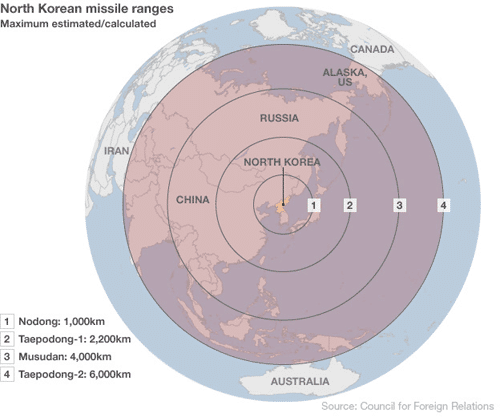On 9 October 2012 a spokesman for the powerful National Defence Commission of North Korea said in a statement carried by the KCNA that ‘the strategic rocket forces are keeping within their striking range not only the bases of the puppet forces [South Korea’s] and the US imperialist aggression forces’ bases in the inviolable land of Korea but also Japan, Guam and the US mainland’.
This announcement would appear to be a response to the recent agreement (announced on 7 October 2012) between South Korea and the US to increase both the range of South Korea’s missiles (from 300km to 800km) and the payload of unmanned aircraft, among other matters. Both the range and the payload had hitherto been restricted in order to avoid an arms race in the Korean peninsula in particular and in North-East Asia in general.
A few days later, a spokesman for the Ministry of Foreign Affairs warned that North Korea would feel freer to test a long-range missile (LRM), probably a Taepodong. This seems improbable in a short-term scenario, as the launch of a similar device (Unha 3) in April 2012 was a complete failure. Furthermore, satellite imagery has revealed that North Korea is still building a new launching pad at the Musudan-ri missile test site.
However, it would be unwise to exclude the possibility of a show of force by the North similar to the attacks carried out in 2010 against the Cheonan corvette and a South Korean island near the border. The North Korean response might well be strictly conventional, as it was then, including perhaps artillery shelling or an attack aimed at a military vessel.
As regards the missile test, it should be remembered that North Korea has a long record of empty threats and rhetorical bluff and also a substantial history of failed test launches. North Korea tested LRMs in 1998 (Taepodong 1), 2006 (Taepodong 2), 2009 (Taepodong 2) and 2012 (Unha 3, the space launcher version of the Taepodong-2), all four of which were considered failures. Most experts believe it is highly unlikely that North Korea has the ability to deploy larger LRMs (for it does not appear to have mastered the technology for multistage rockets), nor has it developed the miniaturisation abilities necessary to mount a nuclear weapon on an LRM, and it is unable to build a re-entry vehicle for its warheads.

The shortcomings mentioned above were first detected in 2009 (following a North Korean missile test) by the US expert Joseph Cirincione in an article for CNN, and they still stand today. For this reason, the possibility of a successful nuclear attack on Alaska or Guam is extremely remote. Although the North Koreans are undoubtedly working hard to overcome these three shortfalls, it is unlikely that they will succeed for many years to come.
In a military parade held in April this year, six road-mobile ICBMs were put on display by the North Koreans. Many experts believe they were mock-ups and not operational devices. However, the large size of the platforms might suggest that North Korea is working on developing a larger LRM, and it is also safe to assume that they are working on miniaturisation and on re-entry vehicles as well.
In short, a North Korean response to recent events will probably not include a missile launch, and it is almost entirely certain that it will not involve a nuclear attack due to the technological reasons outlined above, to which should be added the fear of retaliation, amongst other political considerations. Some scholars tend to think that the North Koreans’ shortfalls in LRM technology are not only substantial but will persist in the future due to the effects of United Nations Security Council resolutions 1718 (2006) and 1874 (2009), which seek to limit the proliferation of Weapons of Mass Destruction.
Notwithstanding the above, the fact that North Korea does not seem to pose an immediate threat with its LRMs and nuclear weapons is no reason for optimism. It should be recalled, first, that North Korea’s conventional forces have considerable clout, and they not only have a significant deterrent capacity (in the face of a possible US-South Korean invasion or a surgical strike, for instance) but pose a clear danger to its southern neighbour, as demonstrated in 2010.
Secondly, and more important, the main threat posed by North Korea is that of consolidated nuclearisation. This may lead to active proliferation (as was the case in Syria) should North Korea transfer nuclear devices or technology to other rogue states or terrorist organisations, or to passive proliferation, possibly leading to the nuclearisation of Japan, South Korea and even Taiwan, in addition to more belligerent policies and conventional clashes with South Korea.
The overarching problem, of course, is that despite continuous efforts by the international community to achieve the denuclearisation of the Korean peninsula, time is passing and working against this goal. And no one can be entirely sure that the North Koreans will not achieve medium-term results in building larger LRMs, miniaturising nuclear weapons and designing a re-entry vehicle for their warheads.
